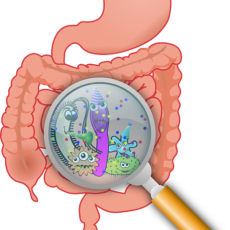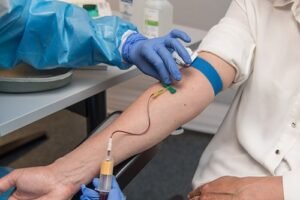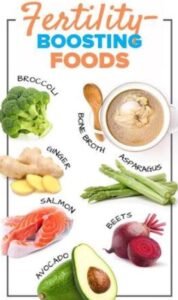In this post I’ll be covering probiotics and fertility- that is, the little beneficial critters that live in our gut!
Life is returning to normal, so I’m back to upgrading my fertility diet. I mentioned in my blog, Digestive Enzymes, Probiotics and Fertility, that I’ll be adding two critical – and missing – components to my fertility diet: probiotic bacteria and enzymes.
What are Probiotic Bacteria?
Probiotic bacteria are the friendly bacteria that live in our digestive systems. Doctors and nutritionists agree that these bacteria are one of the most important aspects to our overall health and well being.
Dr. McDougall refers to them in his book, Digestive Tune-up, as “so important to our health and survival that they should be thought of as a vital organ”. In her book, Allergies, by Carolee Bateson-Koch writes that the cultivation of these bacteria “can mean the difference between radiant health and chronic debilitating conditions”.
Benefits of Probiotic Bacteria
 It’s not a surprise that these little inhibitors are so important to us given the slew of responsibilities they have. Just to name a few of these responsibilities of probiotic bacteria:
It’s not a surprise that these little inhibitors are so important to us given the slew of responsibilities they have. Just to name a few of these responsibilities of probiotic bacteria:
- Break down our food
- Manufacture vitamins like biotin, niacin, folic acid and B-6
- Increase the absorption of minerals
- Normalize bowel transit time
- Produce antibiotics that prevent colonization of the harmful bacteria
A Micro-biome of Life in Our Digestive Tract
Interestingly, this micro flora isn’t just a few bacteria scattered throughout our digestive tract. Trillions of bacteria inhabit our digestive system. The bacteria weigh a total of about four pounds and account for half of the volume of the contents of our large intestine.
Where Does Our Gut Biome Come From?
These bacteria begin to colonize our bodies at birth; finding their way into our system through the air we breathe, the breast milk we drink and the things we put in our mouths.
We need to continuously replenish these bacteria, though, as many don’t set up camp permanently. They regularly exit our digestive systems – making up over half of the dry weight of feces – many of which are still living (if you who weren’t grossed out enough).
What Destroys Probiotics and Fertility?
Excretion isn’t the only factor affecting the bacteria balance in our gut. Bacterial infections, hormones, antibiotics (which kill the good and the bad bacteria), high stress levels, steroid drugs, excessive alcohol intake, poor diet, and a number of other factors can throw the beneficial bacteria out of balance.
Symptoms of Improper Balance of Probiotic Bacteria
This improper balance of flora can cause the following symptoms:
- Acne
- Arthritis
- Asthma
- Ear infection
- Fatigue
- Headaches
- Hormonal disturbances
- Intestinal symptoms
- Irregular heartbeat
- Low back pain
- Nervousness
- Rashes
So, probiotic bacteria are important to our health but what do they have to do with fertility?
Probiotics and Fertility- Can it Help?
There don’t seem to be any studies yet that directly link probiotic bacteria to fertility, but there are two aspects that make it very likely that these bacteria play a role.
- Probiotic bacteria influence our hormones. They break down and rebuild, for example, hormones such as estrogen. Knowing that an imbalance of estrogen can make getting pregnant harder it seems quite likely that a healthy bacteria balance will create a more fertile body.
- Probiotic bacteria manufacture important vitamins like biotin, niacin, folic acid and B-6. And not that it’s a surprise, but a recent study shows that vitamins may play an important role in getting pregnant (not to mention that folic acid is important for a healthy baby – reducing the chances of having a baby with neural tube defects).







 With the information that you give your doctor about your psychiatric history, they can determine the best possible program for you to follow. Make sure that you follow it. Remember it is for your health and that of your baby.
With the information that you give your doctor about your psychiatric history, they can determine the best possible program for you to follow. Make sure that you follow it. Remember it is for your health and that of your baby.
 You will want to go to the hospital as soon as the labor pains are too much to handle, or when they are about 7 minutes apart.
You will want to go to the hospital as soon as the labor pains are too much to handle, or when they are about 7 minutes apart.
 So much for that. All I can do is concentrate on the fact that she means well and as soon as I’m better I’ll be able to say no again – which is guaranteed to be a much sharper no.
So much for that. All I can do is concentrate on the fact that she means well and as soon as I’m better I’ll be able to say no again – which is guaranteed to be a much sharper no.
 A long weekend of crying and healing. We went into the doctor this morning. The tears tried to escape my swollen eyes.
A long weekend of crying and healing. We went into the doctor this morning. The tears tried to escape my swollen eyes. I woke up in a light mood. Richard sang all morning. Against our will, hope had crept back in. We worked out, had a late breakfast and went to the prenatal center. Neither of us was directly stressed.
I woke up in a light mood. Richard sang all morning. Against our will, hope had crept back in. We worked out, had a late breakfast and went to the prenatal center. Neither of us was directly stressed.
 A Danish study
A Danish study Foods that Contain Prebiotics
Foods that Contain Prebiotics
 The old fertility planning looked like this:
The old fertility planning looked like this:
 Zita West (a midwife, nutritionist, and acupuncturist specializing in fertility) in her book,
Zita West (a midwife, nutritionist, and acupuncturist specializing in fertility) in her book, 
 At some point the doctor will ask, “Any questions?”
At some point the doctor will ask, “Any questions?”